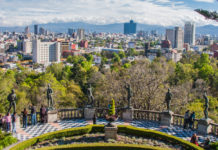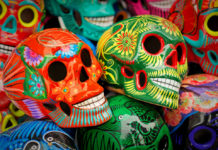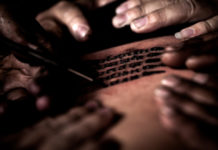Different communities in Mexico have different traditions, mannerisms, and beliefs. However, there is one tradition celebrated universally in the country: Day of the Dead. When it comes to its relationship to death, Mexico is probably one of the most unique places on Earth. Death is respected… But also accepted, and celebrated. All of this is shown in Day of the Dead.
As its name may tell, Day of the Dead is a celebration that venerates people who have died. It is celebrated on November 1st and 2nd. According to the tradition, the souls of children who have passed visit our world during November 1st. On the other hand, the souls of adults arrive on November 2nd.
The origins of day of the dead date from the Pre-hispanic period. Nevertheless, it is heavily influenced by Catholicism and European traditions taken to Mexico during the country’s colonization period. It nowadays incorporates modern elements and foreign traditions as well.
Origins of Day of the Dead: A Pre-Hispanic Tradition

The origins of Day of the Dead are traced to the Mesoamerican cultures that inhabited Mexico before the Spanish conquest. These cultures included Aztecs in Central Mexico, Mayas in the Southeast, and Purepechas in the West, amongst others. Different tribes had Gods that were directly related to death, which showed death as an entity with its own personality. Aztecs had Mictlantecúhtli, the Lord of Death. Mayas had Ah Puch (sometimes also called Yum-Kimil or Hun Ahau), the king of the underworld, who was often represented as a skeleton with a jaguar’s head.
Mesoamerican tribes used to remember those who had passed by taking flowers and food to their burial places. Tribes used to do this for four years after the death of the person. In the case of Aztecs, the tribe believed that after dying, a person could end up in different places: Mictlán, Tlalocan, Tonatiuh ichan, and Cincalco. Here’s more of each of them:
Mictlán: The Underworld
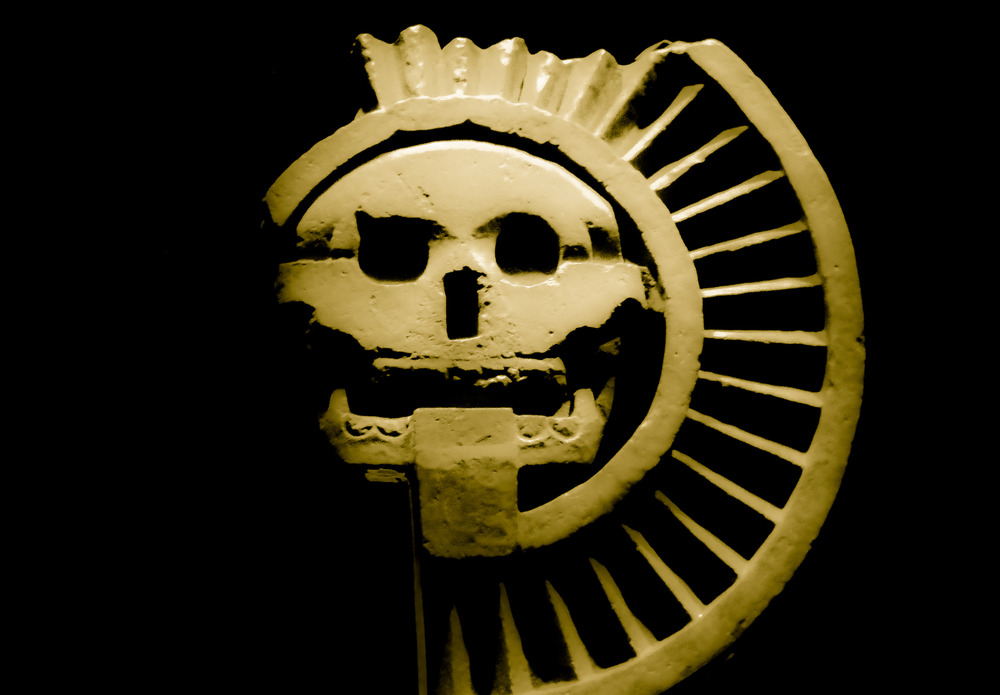
According to the Aztecs, Mictlán, the underworld, was ruled by Mictlantecúhtli, the God of Death. Mictlantecúhtli was sometimes also called “The Lord of the Underworld”. All the people who died of natural causes or diseases that were considered “non-sacred” ended up in Mictlán. The place had nine levels. Those who died and ended up there had to undergo a series of challenges to go from the first to the ninth level. Dogs used to guide the dead through this passage.
Tlalocan: Tlaloc’s Paradise
Tlalocan was a place ruled by Tlaloc, the Aztec God of Rain. Only those whose deaths were related to thunder, water, leper, gout, or other diseases related to Tlaloc ended up there. Tlalocan was full of food and rejoice.
Tonatiuh ichan: House of the Sun
Tonatiuh ichan is the place where warriors killed in combat and women who died giving birth (who were also seen as warriors killed in combat) went. After four years of being in Tonatiuh ichan, the dead would become birds (usually hummingbirds) and go to earth to pollinate flowers.
Cincalco: Children’s Paradise
Cincalco, the home of Tonacatecuhtli, the God of Fertility and Creation, was the place where young children who had passed use to go to. The place was full of trees, fruits, and flowers.
Pre-hispanic tribes used to maintain bonds with those who had passed and were in the aforementioned places. Different dead people were thought to have different roles in important acts for the community. The dead were invoked for magic rituals, support in hunting, harvesting, or combat, and their presence in important events such as births.
In Pre-hispanic times, the dead used to be buried with jewels, vessels with food and water. Sometimes, other elements that could help the person on their way to Mictlan were also included. Regular citizens used to be buried with dogs that would work as a guide on their way to the other world. On the other hand, governors and upper-class individuals used to get buried with slaves to have company on their way.
Day of the Dead after the arrival of the Spanish Conquerors
When the Spanish conquerors arrived in America in the 15th Century, they were terrified by the death-related practices of the Mesoamerican tribes. In an attempt to convert these tribes to Catholicism, the Spanish adapted All Saints’ Day to the celebrations and traditions the tribes used to have. In fact, lots of the traditions related to Day of the Dead still practiced today, date back to European traditions.
Elements typically seen in Day of the Dead altars today, including candles, flowers, and incense all have a Catholic background. Furthermore, “Pan de Muerto” (which literally translates to “bread of the dead”), a type of bread baked during the weeks before Day of the Dead, probably originated in León, Aragón, and Castile, in Spain. People in these regions used to cook food that resembled bones during All Saints’ Day. Moreover, people in Santiago de Compostela and Galicia, leave their table set on December 31st. This is done so that family members that have died could go and share food with them. Something similar to this is what some people believe happens during Day of the Dead.
The “pagan” rituals and beliefs of the mesoamerican tribes, kept intertwining with European traditions little by little.
Day of the Day in Independent Mexico
Mexico officially gained its independence from Spain in 1821. Some historians state that little time after the independence of the country, it was possible to find merchants selling clay skulls and candy skulls in public plazas in Mexico City. The concepts of “death” and “celebration” started to be related during this period. The tradition of decorating people’s tombs also started during this time. So did the tradition of visiting the tombs of the loved ones that had passed away during November 1st and 2nd.

After its independence, Mexico had different leaders. During their governments the gap between social classes kept growing. It was then when drawings of skulls and skeletons that critiqued the country’s situation started to emerge. These drawings were published in different newspapers and usually focused on mocking the upper classes.
The Birth of “La Catrina”
The most famous drawing that existed was called “La Calavera Garbancera”, which then evolved to become “La Catrina”. The closest translation to “La Calavera Garbancera” is “The Garbancera Skull”. A “Garbancero” (if we’re talking about a male) or “Garbancera” (if we’re referring to a female), is a person with indigenous roots that pretends to be European. Thus rejecting their actual heritage. It was common for journalists to mock this kind of people.
“La Calavera Garbancera” is usually represented as the upper torso of a skeleton dressed with an elegant dress and a big hat with feathers. This hat was designed to represent people that wanted to show off and pretend they had more goods or money than they actually did. Sometimes these skulls were also shown riding horses, or in socialite parties. These all intended to show the hypocrisy of the upper classes.
From “La Calavera Garbancera” to “La Catrina”
The name of “La Calavera Garbancera” ended up changing to “La Catrina” or “La Calavera Catrina” in the early 20th Century. This was due to Diego Rivera, a Mexican painter (and Frida Kahlo’s husband). One of Rivera’s murals, “Sueño de una tarde dominical en la Alameda Central” (which translates to something similar to “Dream of a Sunday Afternoon in the Alameda Central”) featured a “full-body” “Calavera Garbancera”, rather than just the torso that used to be depicted earlier in history. Rivera decided to name the skeleton “La Catrina” after the word “catrín”, which depicts an elegant, well-dressed man.
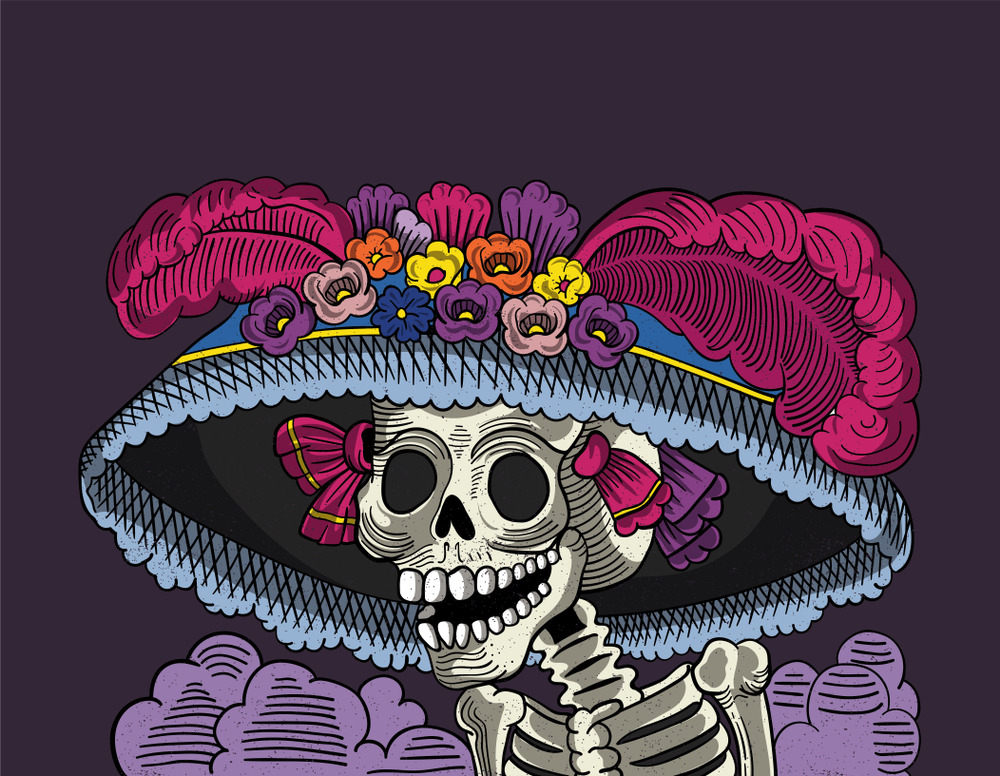
“La Catrina” plays an important role in the contemporary Day of the Dead celebrations, and its image can be found in paintings, clay figures, and the so-called “papel picado”. People also write short poems or verses called “Calaveritas Literarias” or “Literary Calaveritas”. These literary compositions are usually irreverent and talk about living people as if they were dead. They usually feature “La Catrina”, depict the reality and attributes of a person or situation, and in occasions narrate the fictitious way in which the person the piece is about “died” (“La Catrina” usually always “takes” them with her).
In one way or another “La Catrina” is there to remind us that it doesn’t matter if we’re rich or poor, lucky or unlucky, we will all die in the end (but, like, in a funny way).
Day of the Dead Today
UNESCO named Day of the Dead “Intangible cultural heritage” back in 2003. However, the tradition keeps evolving and has become more commercial in the last years. With more people celebrating Halloween in Mexico, and people celebrating Day of the Dead in countries such as the US, it is now common for the two celebrations to intertwine. Day of the Dead-themed ornaments and costumes have become “accessible” in American departmental stores such as Target or online retailers such as Amazon. Fashion magazines such as Marie Claire now publish articles featuring candy skull makeup tutorials. And Day of the Dead has been featured in Hollywood mega projects including Disney’s animated film “Coco” and Columbia Pictures’ and MGM’s “Spectre”:
By the way, the Day of the Dead parade wasn’t a thing until James Bond made it a thing, I mean, it’s still quite cool though)…
Beliefs related to Day of the Dead
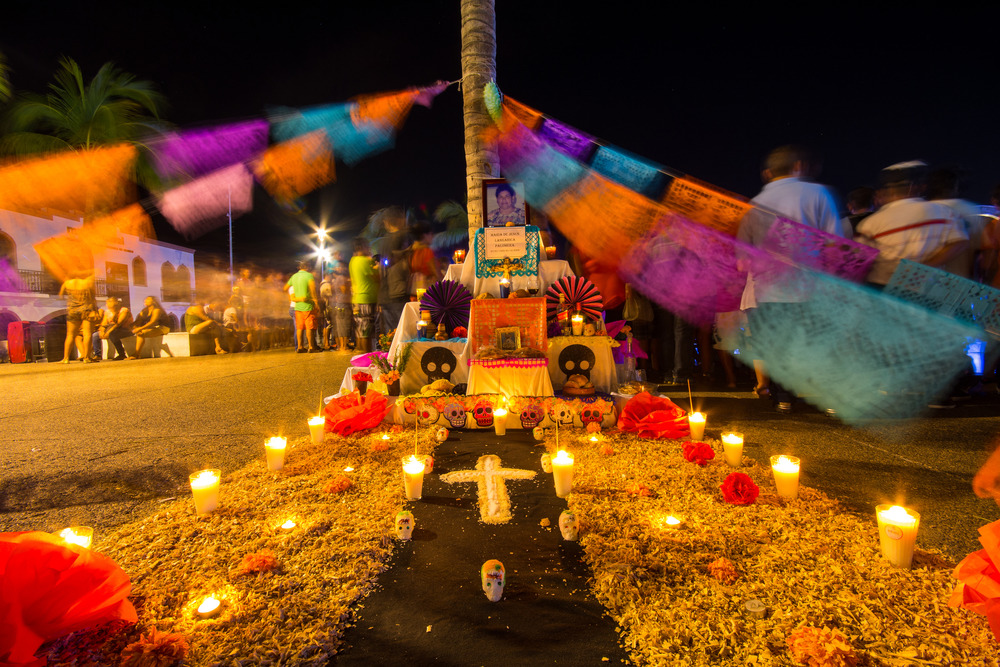
Going back to the more traditional side of Day of the Dead, there are certain beliefs directly related to the tradition. People believe the souls of those who have passed away visit our world during the period of the Day of the Dead celebrations.
As previously mentioned, Day of the Dead is more commonly and widely celebrated on November 1st and 2nd, which are All Saints’ Day and All Souls’ Day, respectively. However, there are certain regions in which the celebrations start earlier, on October 28th, since they believe different types of souls arrive on days other than November 1st and 2nd:
- 28th of October: the day in which those who were killed in an accident or had a sudden and violent death arrive.
- 29th of October: the day in which those who drowned arrive.
- 30th of October: the day in which this who are not remembered by any friends or family arrive (e.g. orphans).
- 31st of October: the day in which those who were not baptized arrive.
- 1st of November: the day in which children who have perished arrive.
- 2nd of November: the day in which those adults who have passed away arrive.
It is believed that the souls arrive in our world every 12 hours during these days. In addition, these dates match with the arrival of thousands of monarch butterflies that emigrate from Canada to Mexico to survive winter time. Mesoamerican cultures such as the Aztecs believed the souls of those who had perished could come back to this world in the shape of either butterflies or humming birds. Thus this massive migration is often related to the tradition as well.
Elements of Day of the Dead
There are some tangible elements that are quite characteristic of Day of the Dead. These include “altares” (or altars), “calaveritas de azúcar” (or sugar skulls), flores de cempasúchil (or Aztec marigold), “papel picado” (or perforated paper), “pan de muerto” (or bread of the dead), “xoloescuincles” (or Xolo dogs), and cemeteries. Let’s explore each of them:
Altares (Altars)

One of the most important elements of Day of the Dead, are the altars built to honor those who have passed. Depending on the region, people might start setting up altars as early as October 28th. Altars usually have two, three, or seven “levels” or “floors”. If an altar has two levels, these represent heaven and earth each. If it has three levels, they represent heaven, earth, and the underworld. Lastly, 7-level altars represent the different stages our should must go through to rest in peace.
Each level or floor is covered with clothes, papel picado, and palm leaves. Furthermore, each of them has a different meaning. People usually place a religious figurine or image on the highest level. They then place candles or lights in the second higher level. Salt is then placed on the third highest level. This is done to make sure that the dead people’s souls remain pure during their trip between worlds. Pan de muerto is placed on the fourth level. People afterwards place the dead person’s/people’s favorite dishes, along with fruit on the fifth level. They then put photographs of the dead person(s) on the sixth level. Lastly, flowers, petals, seeds, or fruits forming a catholic cross are put on the lowest level.
Calaveritas de azúcar (Sugar skulls)
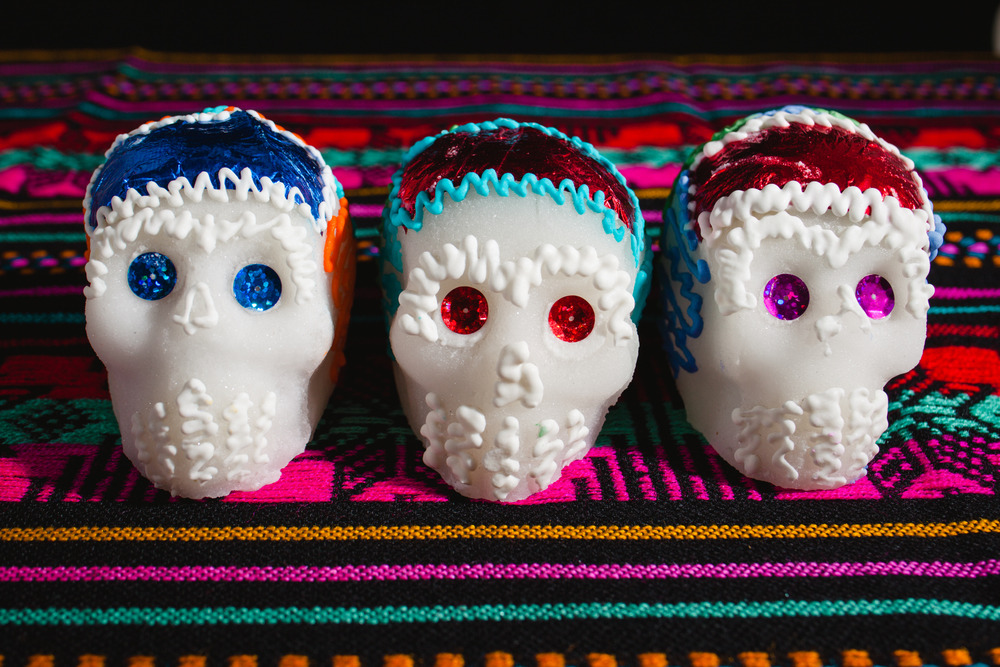
“Calaveritas”, which translates to “skulls”, were a traditional element of ancient altars related to death among different mesoamerican cultures. These altars, called “Tzompantli” had rows of skulls that used to belong to those who were sacrificed to the gods.
After the Spanish arrived, skull-shaped “alfeñiques” (objects made of sugar paste) became popular. These sugar skulls are still commonly made for the modern Day of the Dead celebrations. They are made with sugar, hot water, and lemon, which creates a paste similar to caramel. This paste is molded into the shape of a skull. The “alfeñique” is then decorated with vegetable coloring. In addition these skulls might have name written on their foreheads. If the skull has the name of someone who has perished, it means that the person is remembered by their family. If the name has the name of someone that is still alive, it means that their family or friends are saving a place for them in the underworld.
Skulls made out of materials other than sugar paste are also common in Mexico. These materials include clay and Papier-mâché.
Flores de Cempasúchil (Aztec marigolds)
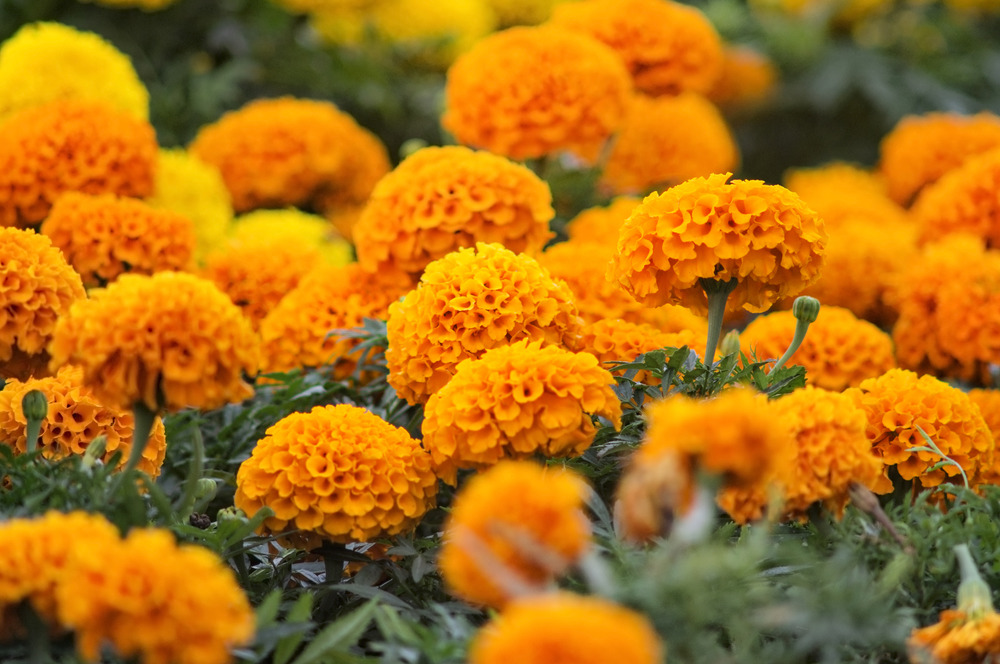
Flores de Cempasúchil, which are called “Aztec marigolds” in English, are fundamental for Day of the Dead celebrations. They are usually orange or yellow and might be up to 110 cm tall. These flowers have had an important role since Pre-Hispanic times. Remains of the plant have been found in different ceremonial sites. Furthermore, Coyolxauhqui, the Aztec goddess of moon was usually represented as having Aztec marigolds on her head ornaments. It is believed that Aztec marigolds act as a guide for the souls returning to this world due to their vibrant color and strong smell.
Each year, around nine thousand tons of Aztec marigolds are harvested in Mexico. This represents a revenue of around $90 million Mexican pesos ($4.5 million USD dollars). Most of these flowers are harvested in Puebla, a state in Central Mexico.
Papel Picado (perforated paper)
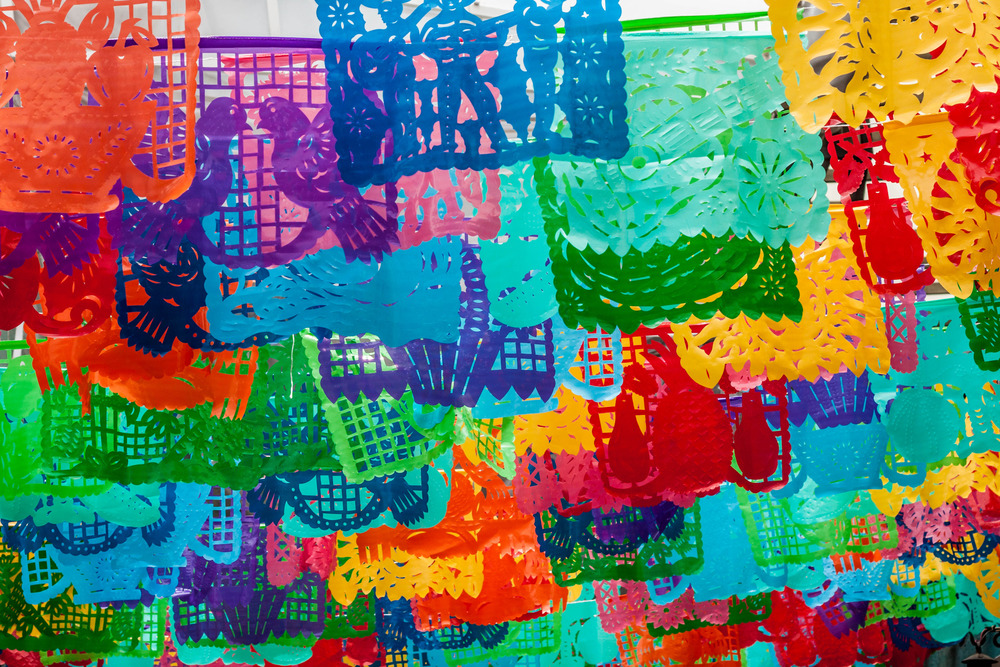
Perforated paper, or “papel picado” is a type of Mexican handicraft that consists of different shapes manually cut out of a piece of paper using chisels and hammers. Papel picado is often used to decorate Day of the Dead altars (even though it can also be used as a decoration during other holidays, such as Independence Day). Its origins trace back to Huixcolotla, a town in the State of Puebla. It was created in the 1800s, when people at “haciendas” started working with the paper they used to wrap the products sold at the aforementioned haciendas. The tradition spread from Huixcolotla to the whole state of Puebla in the early 1900s and then became popular in Mexico City in the 1960s.
Papel picado comes in different colors and each of these has a different meaning. Orange means mourning; purple relates to Catholicism; blue represents deceased people who died in situations related to water; red stands for warriors killed in battle or women who died during labour; green is for those who died during their youth; white represents those who died during their childhood; yellow relates to the elderly; black represents the underworld.
Pan de Muerto (Bread of the Dead)

Pan de muerto is a type of sweetened bread usually baked a couple of weeks before, during, and a bit after Day of the Dead celebrations. Even though there are different types of pan de muerto, the most common one is shaped as a bun and has four little pieces of dough that resemble bones on top of it. Its shape (a circle) symbolizes the cycle of life, whereas the four little “bones” represent the four cardinal points.
The origins of pan de muerto trace back to Pre-hispanic times. There are different versions of this, but one of them says that it originated when certain cultures used to do human sacrifices. One of these sacrifices consisted of removing the hearts of women (often royalty; princesses) and placing them in a pot with amaranth. The person leading the sacrifice would then bite the heart to show the Gods gratitude. The Spanish found the tradition horrifying and eventually prohibited it. They then started baking heart-shaped bread and covering it with sugar dyed in red. The shape and ingredients of the bread evolved until it became what it is today.
Xoloescuincles (Xolo dogs)
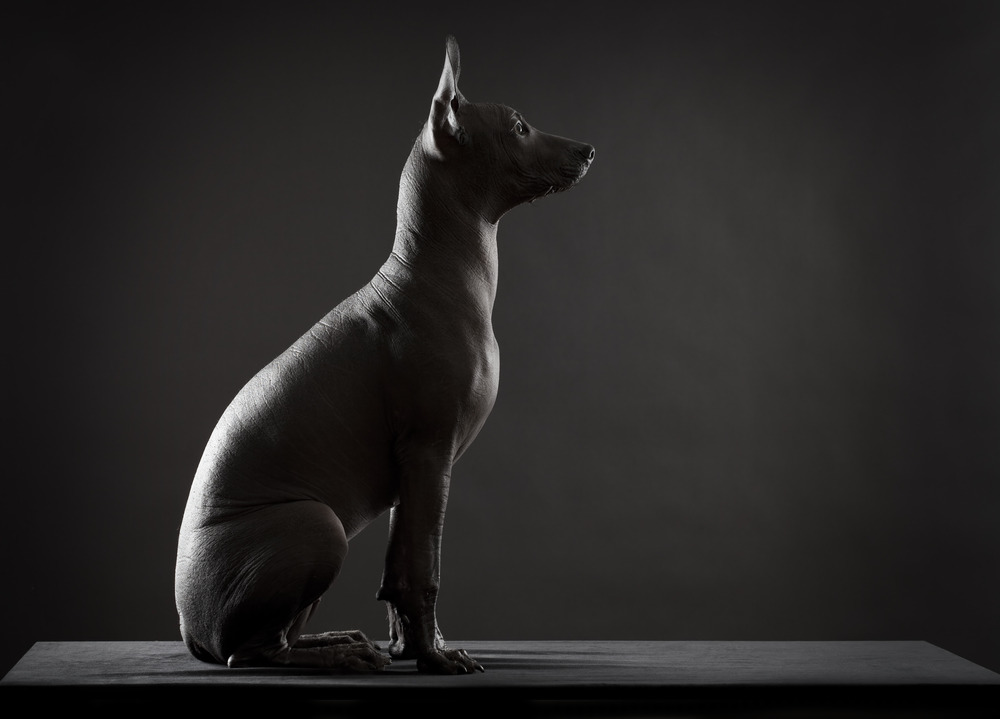
Xolos are one of the oldest dog breeds on Earth. Their origins date to thousands of years ago.
As it was mentioned before, ancient cultures in Mexico believed that people who died from “non-sacred” causes would end up in “Mictlán”, the underworld. Mictlán had nine levels that the perished had to go through. The first level of Mictlán, Itzcuintlan (or “place of the dogs”), was said to be placed next to a river that the dead had to cross to arrive in their next destination.
People needed the help of a Xolo dog to cross the river. Humans would then have to look for a brown dog that was willing to guide them through the river. The dog had to forcibly be brown since white dogs would tell the person they did not want to get dirty. Black dogs would tell them that they were too dark for the dead to see them. To make the journey easier for the deceased, they family would bury them with the remains of a Xolo dog.
The tradition of burying a dog with the deceased evolved, and it is now common to place a a figurine or photo of a Xolo dog in altars.
Cemeteries
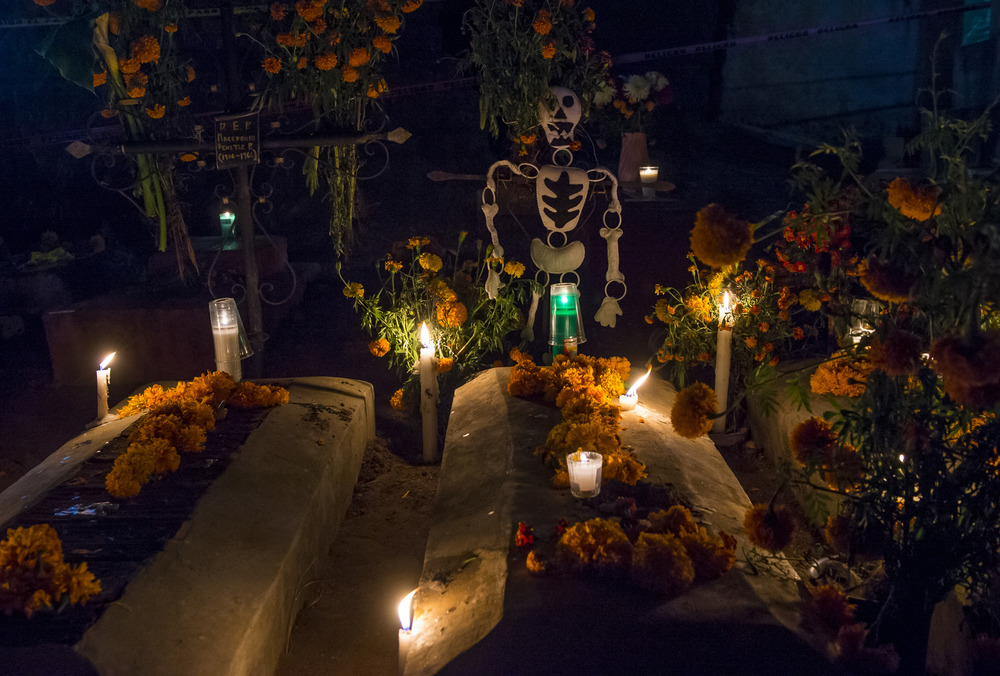
It is common for Mexican communities to visit the graves of their deceased loved ones to clean them and place flowers and candles on top of them. In some places it is also common for people to set altars next to the graves and spend the night at the cemetery. When at the cemeteries, people usually pray, play music, eat and drink.
Headed to Mexico? Best places to spend Day of the Dead
If you want to experience Day of the Dead in its birthplace, there’s towns and cities all over Mexico with specific ways of celebrating Día de Muertos. Here’s a few:
Mexico City
Mexico’s capital is home to several Day of the Dead attractions that go from parades to altars in public plazas.
Day of the Dead Parade

As mentioned before, this tradition is actually new. It started in 2016, the year after the James Bond film “Specter” was premiered. The film’s opening scene features James Bond following a man around the streets of the centre of Mexico City while a Day of the Dead-themed parade is taking place. The film created such an expectation amongst its viewers that Mexico City’s authorities decided to actually organize the parade.
The parade starts in Paseo de la Reforma, one of Mexico City’s most important avenues, and finishes at the “Zócalo”, the city’s main square. It has had different themes throughout the years. In 2016 it was divided in three different segments: “El viaje al Mictlá (Journey to Mictlán”, which depicted the pre-Hispanic traditions related to death; “La muerte Niña (translated to some similar to ‘Young Death’), which showed elements of Day of the Dead after the conquerors arrived; and, lastly, “Pal’ Panteón (translated to something like “Going to the graveyard”)”, which showed different dancing “catrinas”.
In 2017, the parade was divided in two: a section called “La Muerte Viva (The Living Death)”, which depicted how death has been celebrated from pre-hispanic days until today, and a section focused on giant skull puppets. This year the parade also paid tribute to those killed during the 2017 earthquakes in Mexico.
Lastly, in 2018, the parade focused on immigration. Just as in the previous years, it had different sections. These included segments that payed tribute to those immigrants that contributed to the development of Mexico City, showed Mexico City as a refuge for immigrants, and talked about social progress in the city.
Mixquic

While the Day of the Dead parade offers a very Hollywoodesque representation of the tradition, there’s places in Mexico City that show a more traditional side of it. One of these places is Mixquic, a site in the borough of Tlahuac, in Eastern Mexico City.
Every year, the inhabitants of Mixquic set altars, decorate the tombs of their loved ones, and carry out the so-called “Alumbrada”, which roughly translates to “Lightning”. The people of Mixquic place candles and lights all over the local cemetery, which along with the Cempasúchil flowers, “guide” the souls that are crossing to our world.
Guanajuato
Guanajuato, a state in the North Centre of Mexico, is famous for its legends and mysticism. Several of its cities have specific ways of celebrating Day of the Dead.
Guanajuato City
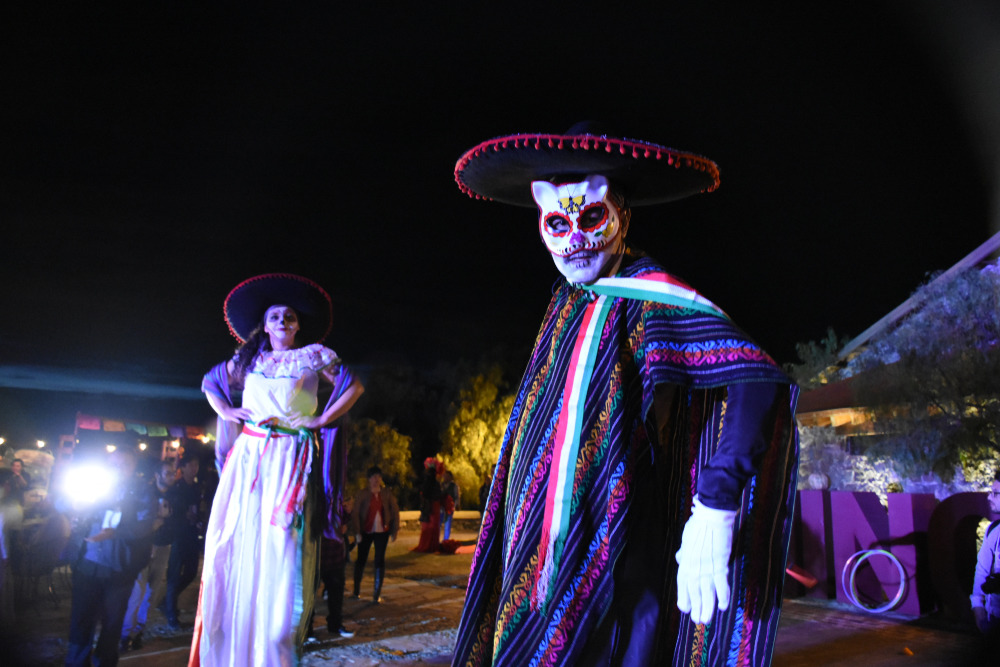
Guanajuato City, the state’s capital was named a UNESCO World Heritage Site in 1988. It is famous for its tunnels, narrow streets and alleys, colonial mansions, and colorful buildings. The city is home to “Festival la Catrina Vive” (which translates to something similar to “Catrina Lives Festival”). Since its first edition in 2014, the festival has done activities that include a Catrina exhibition in the stairs of one of the city’s theaters; a “living Catrina” parade; the so-called “Callejoneadas Macabras” (group walks at night, where the group is accompanied by a band playing music, but with a spooky twist); a scary movie festival, amongst other activities.
The students of the city’s university also set a giant Day of the Dead altar on the stairs of the university. Lastly, artisans from different states have been gathering together for the last 11 years to put a giant Day of the Dead-themed flower carpet together.
San Miguel de Allende

San Miguel de Allende is another city in the state of Guanajuato. Just like Guanajuato City, San Miguel de Allende is a UNESCO World Heritage Site. The city has its very own Day of the Dead festival: “El Festival de la Calaca”, which translates to something similar to “The Skull’s Festival” or “The Skeleton’s Festival”. The festival consists of men and women dressed up as skulls walking and drinking around the city. Asides from this, there’s also guided visits to the city’s cemeteries, short film festivals, and handicraft markets, among other activities.
Michoacán
Michoacán is a state located in Western Mexico. Some of its towns, are famous for their Day of the Dead celebrations.
Pátzcuaro and Janitzio
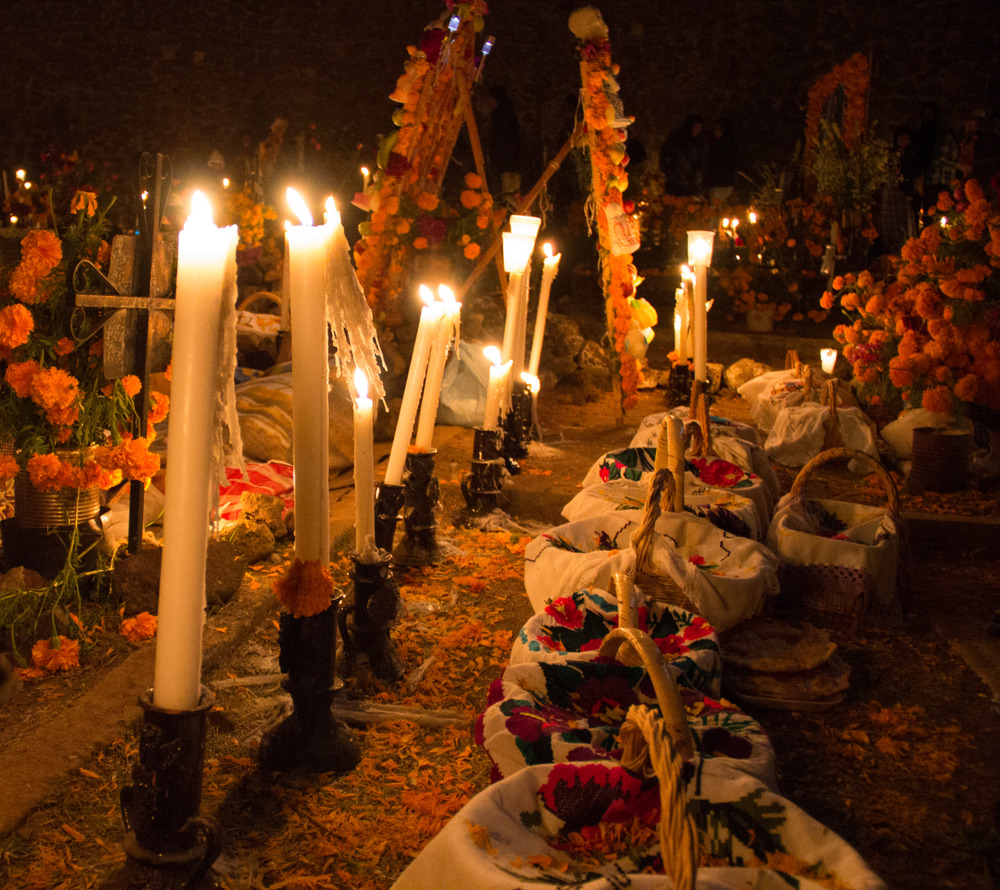
Located in the heart of the town of Pátzcuaro there’s a lake, and in the aforementioned lake there’s a little island called Janitzio. A purépecha community lives in the area. The cemeteries of Janitzio are lit by thousands of candles, and the community place flowers, candy, and food all over the tombs of their loved ones. Just as in other places in Mexico, the celebrations on November 1st are dedicated for those who died during their childhood years. November 2nd is dedicated to those who perished during their adulthood.
Yucatán Península
The Yucatán Península is an area in Southern Mexico famous for Cancun, spring breakers, beautiful beaches, and lately… Day of the Dead, which is different than in other states because it is influenced by the Maya culture.
Playa del Carmen, Quintana Roo

Playa del Carmen is a city located in the Riviera Maya, a touristic area in Quintana Roo. Located in Playa del Carmen, there is a theme park called Xcaret. Xcaret has organized the “Festival de Vida y Muerte” or “Life and Death Festival” since 2016. The festival has theatre performances, dancers, and concerts. Furthermore, the festival features traditions from a specific Mexican state every year.
Cobá, Quintana Roo
Cobá is an archaeological site located in Quintana Roo. It was inhabited by the Mayas starting in 200 BC. What makes the place special is that its inhabitants have the tradition of exhuming the bones of their dead loved ones on Day of the Dead. They exhume the bones of their family members so that they can clean them and the niches where the bones are placed. The inhabitants of the see this as a way of spending time with those they love, even though they’re not actually physically together.
Yucatán
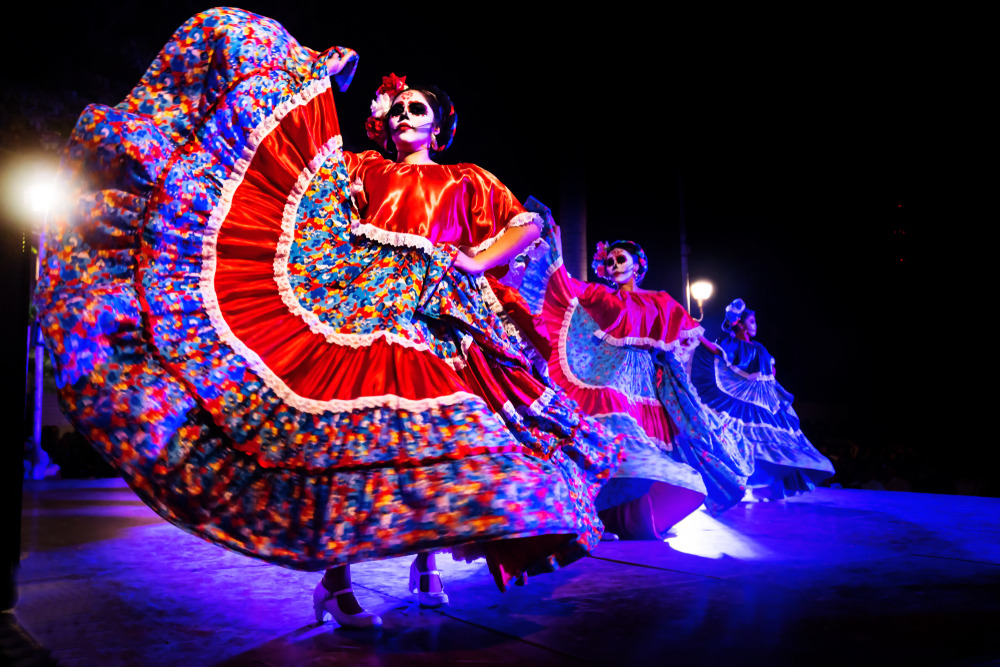
Yucatán is one of the three states in the Yucatán Península. The state celebrates Hanal Pixán, the Maya term for “souls food”, a tradition that celebrates those who have perished. Just as in the other regions of Mexico, the Mayas used to believe the souls of those who has passed away could visit our world during Hanal Pixán. Yucatán organizes an event called “Paseo de las Ánimas” or “Walk of the Souls” in Mérida, its capital. The event consist of people with skull-themed makeup walking around the city.
Puebla
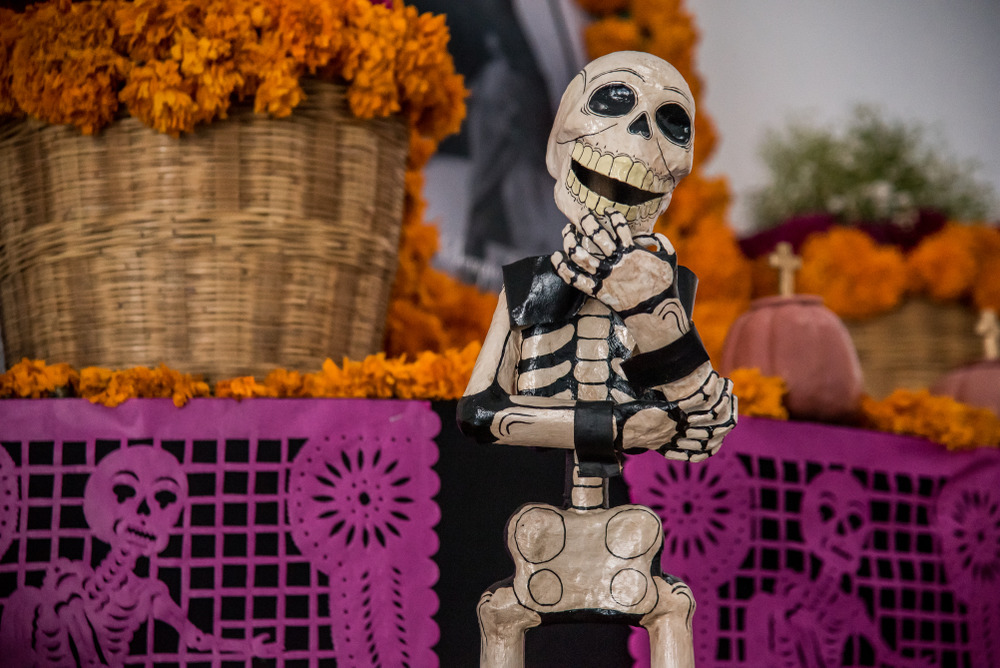
Puebla, as previously mentioned, is a state in Central Mexico. It is home to a variety of traditions and towns that celebrate Day of the Dead in a unique way.
Chignahuapan
Chignahuapan is a town in Northern Puebla. The town has a lagoon, where the “Light and Life” festival takes place every Day of the Dead. The festival consists of a representation of the path the dead must follow when they perish. The representation, which literally takes place in the middle of the lagoon, has tenths of actors and lights, together with candles floating in the water, boats, and music. In addition to the representation, there is also a a tradition called “El camino de las mil luces” or “Path of a thousand lights”. This tradition consists of hundreds of people walking for the town center to the lagoon. The whole crowd carries torches and flowers.
Atlixco de las Flores
Atlixco de las Flores is a town in Western Puebla, it is located at the foot of the Popocatepetl volcano. Even though it was heavily damaged by the 2017 Puebla earthquake, it has still held its traditional Day of the Dead celebrations during the last two years. One of these traditions in the yearly flower carpet. This carpet has an area of over 1,000 square meters and is made up of 42,000 flowers. The carpet usually forms different skulls. The town also has a skull parade. Here, people dress up as skulls and carry giant skull-shaped dolls around the town.

Day of the Dead, without a doubt, is an absolutely unique tradition. It summarizes the history of Mexico, going all the way from pre-Hispanic times to modern days. Day of the Dead also plays an important role in the country’s way of seeing life and death. It manages to get different regions together to celebrate their dead loved ones.
Make sure to check other culture-related articles here.






